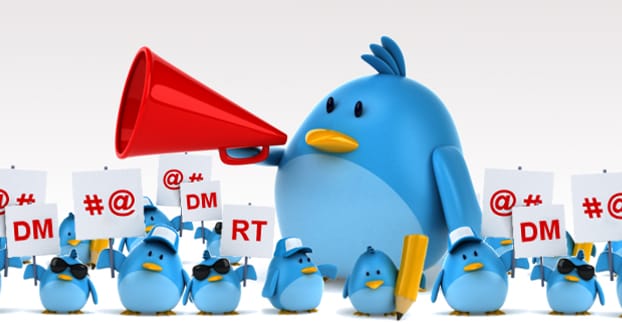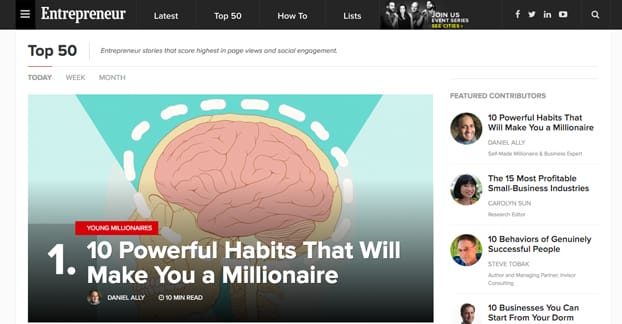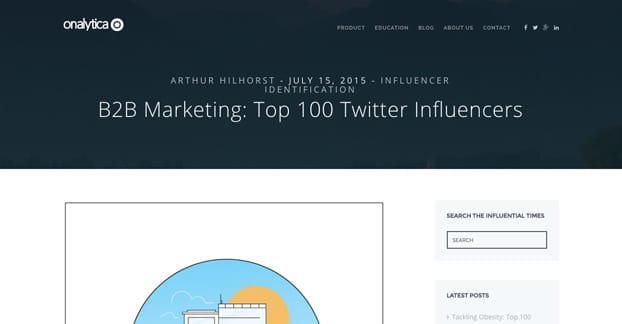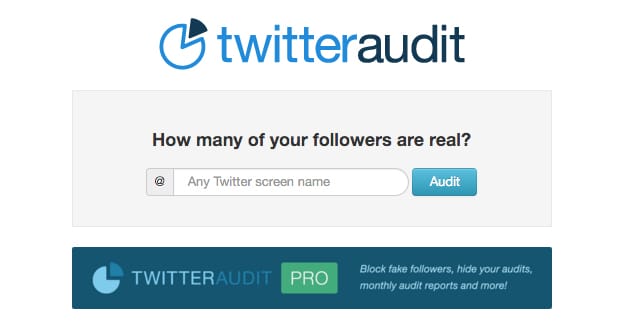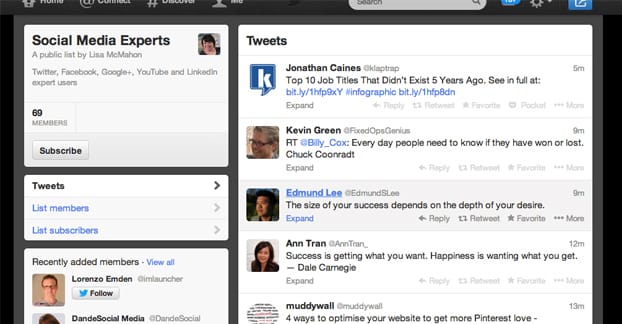Influencer marketing on Twitter is really the key to success with marketing on the site. It’s a long, slow process to build up followers normally, and those followers frankly don’t do much to help you on Twitter itself. Meanwhile, a single retweet from a single influencer can get your link in front of as many people as an entire month of your normal marketing would.
So, you want to work with influencers, but you don’t know where to begin. Thankfully, you’ve come to the right place. I’m here to help you get started, and establish a process you can use for as long as the tools work and Twitter exists.
The General Process
Influencer marketing isn’t complex, but you have to make sure you know what you’re doing each step of the way. Before we get into specific instructions, though, you should know what the overall process and goal is. It will look a little something like this.
- Identify potential influencers within your niche.
- Check to make sure those people are actual, active influencers.
- Begin interacting with those marketers to build a relationship.
- Attempt to get the attention of those influencers and get retweets.
- Repeat the process for as many influencers and for as long as you like.
As you can see, it’s simple in concept but complex in execution. How do you identify influencers? How do you check their viability? How do you interact with them without becoming a pest or being blocked as a spammer? Read on to find out.
Identifying Influencers
There are three major ways to come up with influencers in your industry. I’ll start with the least effective and move on from there.
The first method is to simply brainstorm. Think about your industry. What blogs do you consider influential? With internet marketing, you might name names like Quicksprout, Kissmetrics, Backlinko, Moz, and Search Engine Journal. You can also extend to the marketing sections of sites like Inc, Entrepreneur, Forbes, and the Huffington Post. These are all great resources.
Think about the big names that come to mind in your industry as well. People like Kim Garst, Rand Fishkin, Neil Patel, Kristi Hines, and so forth all fit the bill for the marketing example.
Don’t forget the more niche sites that, while they might not have as big a reputation as something like Moz or Forbes, can still have significant followings.
Create a list of names. Write down any name you can think of or you can find while browsing any one of these sites. Go through blog author lists and contributor pages, browse recent posts for names and references, and spiral out as much as you can. Don’t worry about having a long and unwieldy list; you’ll prune it down later.
The second method is to play off of people who have already done some of this research. For example, I can run a Google search and find articles like this one, which shows the “top 100” B2B marketers on Twitter. I don’t think that particular article is the best, given that it professes to care about normalized PageRank, while simultaneously not listing any follower or activity counts, but that’s fine. We only need posts like this for a list of names; we’re doing our own filtering later. Chances are you’ll find a few such lists, though you may have to run more niche searches for some industries.
When you get lists like this, add their names to your list. A lot of them will be redundant, so keep the entry with the name and the Twitter handle. The next step was already to look up their Twitter handle, to make sure they have one, so this cuts out some of the work for you.
The third method is to use a tool for discovery. There are a lot of tools that profess to show a list of influencers, so it’s up to you to decide which one you like the most. This is one area that will really depend on your preferences.
- Use the Twitter advanced search to look for specific industry phrases that can show up in profiles and tweets. Likewise, search for hashtags to find people using them. Not all of them will be influencers, so look for accounts with a sizable number of followers.
- Use the paid version of BuzzSumo. You can search for a keyword and get a list of current trending content within it, but that’s about it for the free version. For the paid version, you can click over to the “top authors” or the “influencers” tabs, to check out what they identify as influential accounts. Note that this is in general for sites other than Twitter, so you’ll have to do some filtering. Thankfully, most influencers will be present all over, rather than just Twitter.
- Use the Moz-made tool FollowerWonk to identify influencers based on an organic analysis of your own Twitter feed, finding influential people who post the same kinds of content.
At the end of this process, you should have a relatively large list of potential influencers in your niche. Now apply the first basic filters; remove anyone who doesn’t actually have an active Twitter account or who posts under a joint account for a brand, and remove anyone who has fewer followers or less activity than you. This will prune out the “influencers” who aren’t actually influential at all.
Checking Influence
The second part is to check over your list and discover which users are actually influential and which have an audience that won’t help you. Believe it or not, some big-name Twitter users have a high proportion of fake followers, or they don’t tweet much, or they just don’t interact much in your actual area of influence. Katy Perry might have a huge number of followers, but she’s pretty unlikely to ever retweet something about internet marketing, so she’s not a valid influencer.
One tool I like to use to determine how legitimate a user’s audience happens to be is Twitter Audit. You can plug in any name and it will take a sample of 5,000 of the followers of that account. It checks various metrics of those followers, like tweet date and number of tweets, and determines whether they’re likely to be bad accounts. It then gives you a reading of how legitimate that user’s following is.
Since this is a sampling, it’s not highly accurate. That said, anything above 50% is probably fine. Everyone racks up some fake followers on Twitter, it’s only when they have more fakes than real users that the problems start.
This method should prune a couple of your accounts, or maybe more depending on your industry. Internet marketers on the legitimate end of the spectrum tend to have very clean accounts, while marketers who pay shady low-cost companies to do their social media for them may end up with a significant fake following. You might be surprised at what you see.
The second method I like to use comes from Majestic SEO. They have a metric known as Topical Trust Flow, which is a measurement and analysis of incoming and outgoing links. When you apply this to a Twitter account, you are presented with a lot of specific information about that specific user. In particular, you will want to look at the topics for which that user is known to be relevant. Occasionally, you will find a user who has topical trust in topics that aren’t actually related to your industry. That means, essentially, that they’re faking. The links that point at their content are bad, or come from unrelated sites, or are otherwise valueless.
You will have to pay for an updated version of Majestic if you want all of this data, as well as the ability to import a whole list and get reports on everyone on it. The cheapest plan is $80 per month, which isn’t cheap, but you only need it for a month. Plus, Majestic has a whole lot of extra tools you can use if you want, so it’s not necessarily wasted money.
Low-Key Interactions to Establish a Presence
At this point, you have a nice filtered list of potential influencers. It’s time to do something with them. There are two options here; you can follow them, or you can add them to a list.
Following influencers gets them on an immediate feed directly into your homepage on Twitter every time you open it. As long as you’re on Twitter, you won’t miss what they have to say. On the other hand, if your list is more than 50-100 people long, you’re going to very quickly find yourself overwhelmed. How many tweets can you parse and follow in a day? If you consider the average influencer tweets 4-10 times per day, if you follow 100 of them, that’s a huge pile of content being posted at peak hours for you to follow.
Lists solve that problem by making it all a separate feed, but that’s a problem in and of itself. When all of that content is on a separate feed, you miss out on it if you’re not watching. The only difference is that it doesn’t drown out the other followers you have.
I personally like to do a hybrid. I will take the majority of the list of influencers and build a Twitter list. You can do that fairly easily, and I would recommend keeping it private, so you don’t have people bugging you to be added to it. Then again, there are some list marketing advantages you can get, if you want to make managing a list into part of your overall marketing. That one’s up to you.
One everyone is on a list, I’ll pick the 10-20 top influencers and follow them directly. These are the influencers I want to focus on the most, and they’re the influencers who are most likely to be posting the best content.
Speaking of the ones you want to focus on, now is when you pick them. I recommend selecting only 5 or so, because you’re going to be interacting with all of them, but focusing on a few. The fewer you pick to start, the less swamped you’re likely to be.
I recommend picking a couple of top-tier “this will be amazing for my business” influencers, and a couple of low-tier “these are more likely to actually share my content” marketers. Mix it up so you’re not relying on the minimal incremental growth of some small time influencers, and you’re not relying on hopefully being the one out of thousands to get the attention of a top level marketer.
Now, what you’re going to start doing is getting yourself on their radar. You’re going to interact with and engage with them in a low-key way, to make sure they keep seeing your name, but not in a way that is spammy or off-putting. You don’t want them to block you, and you don’t want them to associate you with bad conversations or stupid questions.
Start off with just watching their feed and retweeting/liking content they post that is both good and fits with your audience. Don’t go though and just retweet everything, though; that makes you look like a bot. Curate value from their feeds.
While you’re monitoring their feeds, watch for times they ask questions or leave something open. Take these opportunities to contribute! Answer their questions in a way that provides value to them, perhaps something they can use in future articles. If you’ve written on the subject before, provide a link to the content you posted. Make them aware that you’re more than just a face retweeting content, you’re someone with a business, a mind, and content of your own.
Keep this up and you’ll be having actual conversations with them in no time. The problem is, conversations don’t pay the bills. You need to take things one step further if you want to get the retweets, mentions, and links you deserve.
Targeted Interactions to Gain Attention
This is where you take things to the next level. All of these engagements, all of this relationship building, it’s all leading up to making the influences aware of you. Now it’s time to turn that awareness into something more.
I recommend writing content either in direct response to something they said – particularly if it’s an opinion you don’t share – or content that plays off of theirs. Content that references them and links to them is ideal. Content that challenges them or supplements them in a real, tangible way is even better.
The idea here is to create something worthy of their attention and, more importantly, worthy of the attention of their followers.
When you publish the content, share it on your Twitter, and @mention them when you do. You can share it normally and say “by the way, I referenced @user’s great content for this” just to notify them. Or, if it’s a more directly challenging post, you can directly address them. “I didn’t think @user was right with their post about X, so I put forth my angle.”
This is the kind of thing that doesn’t work if you come out of nowhere to do it. They’ll just think “who the heck is this guy?” and ignore you. However, if you’ve spent weeks or months leading up to this with solid engagement, they’ll be more likely to check it out. If you’ve been having solid conversations with them, they’ll even respect your opinion and be interested in the challenge.
The end result of this, ideally, is a retweet, a mention, and/or a link to your site from the influencer. If you’ve created content that is evergreen and well worth referencing, it can even be a source of ongoing engagement and links. If it’s a more timely reference or reaction, it will get you a short burst of engagement, but still gets you visibility with their audience.
The key now is to continue. Keep up your low-key engagement with these influencers, and pull out the high-level targeted posts rarely. It becomes very transparent if you keep targeting the same influencer time after time, and it becomes very obvious if you’re targeting them just for their audience. However, if you’re doing this to a bunch of different influencers, and you’re participating in conversations all around the industry, you’re no longer exploiting them for their engagement.
You’re simply trying to be an influencer yourself, and putting in the work to do it.
